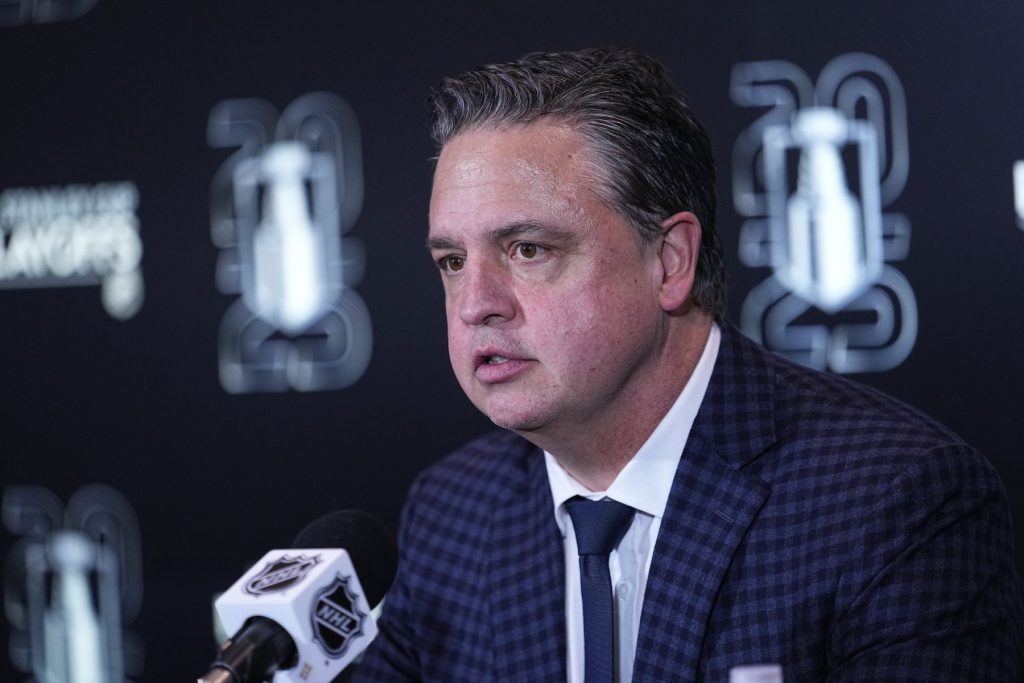When the Ottawa Senators solidified their wild-card seed, clinching their first postseason berth in eight years, they knew in their first-round matchup that they would be the underdog.
For all the discussion about how this young core would be experiencing its first taste of the postseason, the question was which version of the Senators would show up.
Through the first 20 minutes, the Senators looked every bit the inexperienced group. Although they outshot Toronto 13-5 in the opening frame, moments of nervousness pervaded their play.
And worse, the easily identifiable areas of concern were all exacerbated in the early going.
After being the Senators’ best defensive pairing from the beginning of the season through December, the five-on-five struggles of the Thomas Chabot-Nick Jensen pairing since the turn of the calendar year are well documented.
October – December 31: 36 games, 512:02 TOI, 54.47 CF%, 54.87 SF%, 59.62 GF%, 54.40 xGF%
January 1 – onward: 33 games, 472:13 TOI, 48.40 CF%, 44.64 SF%, 46.67 GF%, 44.35 xGF%.
Their downturn predictably coincided with the emergence of an undisclosed lower-body injury to Jensen, but to his credit, the veteran defenceman has remained in Ottawa’s lineup.
If the Senators have any chance of upsetting the Maple Leafs, they need that pairing to play at a level resembling its early season play. In the first period, two poor reads by Thomas Chabot contributed to the Leafs’ first two goals.
On Oliver Ekman-Larsson’s opening tally, Chabot chased the puck carrier, Scott Laughton, high to the wall, vacating his position. He likely expected help and back pressure from the forwards, but they were late coming back.
On the second, Chabot was the far-side defenceman caught as Mitch Marner split Chabot and Jensen before receiving a breakout pass from Auston Matthews.
Channelling excitability productively is integral for any group basking in their first taste of the postseason. In the postseason, there is always a fine line when it comes to being overly aggressive, and the Senators were just that, handing the Leafs six power plays, with three of the infractions occurring deep in the Senators’ offensive zone.
Before the start of the series, Shane Pinto shared his thoughts on how to shut down the Maple Leafs’ power play.
“Hopefully, just stay on the box the whole series,” Pinto said through a smile. “They have five talented players on one unit, so we have to try to just eliminate their time. Try to be aggressive.
“Faceoffs are important, (Giroux) does a great job. (Ridly) does a good job. So, just eliminate their zone time, do the best we can with their break-ins, and hopefully, try to shut them down.”
Affording that many opportunities to a Leafs power play that has clicked at a 30.8 percent success rate since February 1, is self-inflicted foolery. Interestingly, Giroux’s uncharacteristic struggles in the faceoff dot (four for 11) also indirectly contributed to the Leafs’ three power-play goals, which were scored quickly off draws.
Head coach Travis Green shared his thoughts on the Senators’ penalty troubles following the game.
“(We) definitely have to stay out of the box,” he acknowledged. “I’ll say that. At the end of the game, sometimes things are going to get a little out of hand.
“Once in a while, I thought, there was a couple of calls that they did a good job selling.”
Linus Ullmark entered the 2025 playoffs with a career playoff record of three wins and six losses in 10 appearances. His career .887 save percentage and a goals against average of 3.59 are not particularly flattering either.
It is a small sample size of games for the Senators’ goaltender, but allowing six goals on 24 shots will not bolster those career numbers.
For the Senators to climb back into this series, they need saves, especially at pivotal times in the game to preserve momentum.
When asked to describe his performance tonight, Ullmark took an optimistic approach.
“There’s some things (to work on),” he stated. “There’s a high skill team on the other side. We’re just going to have to refocus on the next one. It’s just one game.
“That’s the view of it. Doesn’t matter how you play one game and you lose it, you can lose 1-0 (or by) a lot. So, it’s just (important to) have the mind of a goldfish.”
One of the clear messages from the players and coach following the game was that there were some positives to build on.
Since February 1, the Leafs’ shot and expected goal metrics cratered.
43.62 CF% (32nd)
46.97 SF% (28th)
57.50 GF% (6th)
45.73 xGF% (30th)
In game one of the quarter-final series, the Senators looked like the better five-on-five team, despite their apparent nervousness early on. According to NaturalStatTrick’s game data, the Senators generated the majority of the shots (64.00 CF%), shots on goal (67.50 SF%), and expected goals (64.79 xGF%). Regarding scoring chances, the site had the Senators outchancing the Leafs 22-12 at five-on-five (64.71 SCF%).
“It’s been one game,” Drake Batherson emphasized, while discussing what his team can do better. “I think we’re just getting our feet wet. I thought our five-on-five game was good.”
Brady Tkachuk echoed that sentiment.
“I think we just got a little careless with our sticks,” the captain said while describing what the team can do better. “We just need to be more disciplined and continue to play the way that we need to play five-on-five because we played a pretty solid five-on-five game and (need to) capitalize on our chances when we get them.”
The Senators do not have to search hard for reasons for optimism. If Toronto’s five-on-five struggles continue, the Senators will have a shot.
They just need the other areas of their game to step up. And after Sunday night’s penalty kill and goaltending performance, let’s just say there’s plenty of room to improve.
When the Ottawa Senators solidified their wild-card seed, clinching their first postseason berth in eight years, they knew in their first-round matchup that they would be the underdog.
For all the discussion about how this young core would be experiencing its first taste of the postseason, the question was which version of the Senators would show up.
Through the first 20 minutes, the Senators looked every bit the inexperienced group. Although they outshot Toronto 13-5 in the opening frame, moments of nervousness pervaded their play.
And worse, the easily identifiable areas of concern were all exacerbated in the early going.
After being the Senators’ best defensive pairing from the beginning of the season through December, the five-on-five struggles of the Thomas Chabot-Nick Jensen pairing since the turn of the calendar year are well documented.
October – December 31: 36 games, 512:02 TOI, 54.47 CF%, 54.87 SF%, 59.62 GF%, 54.40 xGF%
January 1 – onward: 33 games, 472:13 TOI, 48.40 CF%, 44.64 SF%, 46.67 GF%, 44.35 xGF%.
Their downturn predictably coincided with the emergence of an undisclosed lower-body injury to Jensen, but to his credit, the veteran defenceman has remained in Ottawa’s lineup.
If the Senators have any chance of upsetting the Maple Leafs, they need that pairing to play at a level resembling its early season play. In the first period, two poor reads by Thomas Chabot contributed to the Leafs’ first two goals.
On Oliver Ekman-Larsson’s opening tally, Chabot chased the puck carrier, Scott Laughton, high to the wall, vacating his position. He likely expected help and back pressure from the forwards, but they were late coming back.
On the second, Chabot was the far-side defenceman caught as Mitch Marner split Chabot and Jensen before receiving a breakout pass from Auston Matthews.
Channelling excitability productively is integral for any group basking in their first taste of the postseason. In the postseason, there is always a fine line when it comes to being overly aggressive, and the Senators were just that, handing the Leafs six power plays, with three of the infractions occurring deep in the Senators’ offensive zone.
Before the start of the series, Shane Pinto shared his thoughts on how to shut down the Maple Leafs’ power play.
“Hopefully, just stay on the box the whole series,” Pinto said through a smile. “They have five talented players on one unit, so we have to try to just eliminate their time. Try to be aggressive.
“Faceoffs are important, (Giroux) does a great job. (Ridly) does a good job. So, just eliminate their zone time, do the best we can with their break-ins, and hopefully, try to shut them down.”
Affording that many opportunities to a Leafs power play that has clicked at a 30.8 percent success rate since February 1, is self-inflicted foolery. Interestingly, Giroux’s uncharacteristic struggles in the faceoff dot (four for 11) also indirectly contributed to the Leafs’ three power-play goals, which were scored quickly off draws.
Head coach Travis Green shared his thoughts on the Senators’ penalty troubles following the game.
“(We) definitely have to stay out of the box,” he acknowledged. “I’ll say that. At the end of the game, sometimes things are going to get a little out of hand.
“Once in a while, I thought, there was a couple of calls that they did a good job selling.”
Linus Ullmark entered the 2025 playoffs with a career playoff record of three wins and six losses in 10 appearances. His career .887 save percentage and a goals against average of 3.59 are not particularly flattering either.
It is a small sample size of games for the Senators’ goaltender, but allowing six goals on 24 shots will not bolster those career numbers.
For the Senators to climb back into this series, they need saves, especially at pivotal times in the game to preserve momentum.
When asked to describe his performance tonight, Ullmark took an optimistic approach.
“There’s some things (to work on),” he stated. “There’s a high skill team on the other side. We’re just going to have to refocus on the next one. It’s just one game.
“That’s the view of it. Doesn’t matter how you play one game and you lose it, you can lose 1-0 (or by) a lot. So, it’s just (important to) have the mind of a goldfish.”
One of the clear messages from the players and coach following the game was that there were some positives to build on.
Since February 1, the Leafs’ shot and expected goal metrics cratered.
43.62 CF% (32nd)
46.97 SF% (28th)
57.50 GF% (6th)
45.73 xGF% (30th)
In game one of the quarter-final series, the Senators looked like the better five-on-five team, despite their apparent nervousness early on. According to NaturalStatTrick’s game data, the Senators generated the majority of the shots (64.00 CF%), shots on goal (67.50 SF%), and expected goals (64.79 xGF%). Regarding scoring chances, the site had the Senators outchancing the Leafs 22-12 at five-on-five (64.71 SCF%).
“It’s been one game,” Drake Batherson emphasized, while discussing what his team can do better. “I think we’re just getting our feet wet. I thought our five-on-five game was good.”
Brady Tkachuk echoed that sentiment.
“I think we just got a little careless with our sticks,” the captain said while describing what the team can do better. “We just need to be more disciplined and continue to play the way that we need to play five-on-five because we played a pretty solid five-on-five game and (need to) capitalize on our chances when we get them.”
The Senators do not have to search hard for reasons for optimism. If Toronto’s five-on-five struggles continue, the Senators will have a shot.
They just need the other areas of their game to step up. And after Sunday night’s penalty kill and goaltending performance, let’s just say there’s plenty of room to improve.









